June 2018 Partner Newsletter: Dugong and seagrass conservation in Mozambique
June 20, 2018
The information below is a reproduction of the original newsletter from our project partners in Mozambique. Click here to download the original newsletter.
The Dugong and Seagrass Conservation Project continues its work to protect and conserve the dugong population in Mozambique as well as its habitat. Mozambique has a population of approximately 250 to 300 dugongs in the Bazaruto Archipelago region, which is possibly the last significant dugong population on the entire East Coast of Africa. In this newsletter, the reader can learn about the results and the most important activities carried out during the period from April to June 2018.
Presentation of results of the legal and policy gap analysis
The Dugong and Seagrass Conservation Project was supported by consultants from Tuya Consulting in order to identify legal and policy gaps relevant to consolidate the project’s efforts in the conservation and protection of dugongs and seagrass. The preliminary results of the study were presented and validated at a workshop held at the National Directorate of Biodiversity (DINAB) on June 4. Participants included the institutions and partners involved in the project as well as external organizations and institutions with crucial experience in conservation of protected marine species. The objectives of the workshop were to present the results and recommendations of the analysis and receive feedback from the partners.
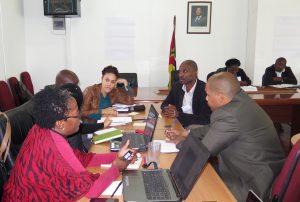
During the workshop the project achievements, the challenges and the visions for future interventions in the conservation of dugongs and seagrass were discussed. Many good suggestions and recommendations were given by the participants, including the need to strengthen the general knowledge of the relevant legislation, measures to strengthen institutional coordination to improve the effectiveness of dugong protection, and practical technical aspects, such as setting up a field office in the Bazaruto Archipelago. The final version of the legal analysis report will be finalized in mid June.
Great advances in sea grass monitoring
The Endangered Wildlife Trust (EWT) has in collaboration with the Bazaruto Archipelago National Park (BANP) and the University of Eduardo Mondlane (UEM) been working towards trialling and introducing an effective, non-invasive fish monitoring programme for the National Park. This new programme focuses on the seagrass ecosystems, which are as important as coral reefs, even if this is not always recognized. Among their key values are providing nursery areas for juvenile fish, supporting the livelihood of artisanal fishers and being the primary food source for the endangered dugongs.
The team has reached important results in building a baseline database for seagrass specific fish and comparing total no-take zones with limited and multi-use zones. EWT has trained rangers from the BANP as well as a student from UEM in the technique. It is expected that the information gathered through these studies will contribute to improved management of the Marine Protected Area of BANP. With their focus on strengthening local capacities and introducing innovative methodologies, the seven-year presence of the Endangered Wildlife Trust in the BANP has contributed significantly to improving dugong and seagrass conservation in the park.
Increased information to the Mozambicans about dugong and seagrass conservation
On May 13, a documentary programme on dugongs and seagrass as well as the effort to protect and conserve them was broadcasted on the national television channel TVM (Televisão de Moçambique). The project partners accompanied and supported the TVM team in collecting information and conducting interviews for the programme during the month of April. This has been an important step towards increasing the access of the Mozambican public to information on the situation of the dugongs and seagrass as well as the efforts to protect them. The programme can in the future also be used as a resource for environmental education.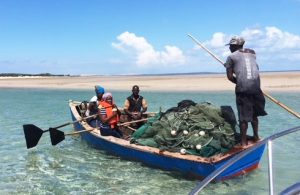
Conclusion of aerial surveys
The last aerial survey within this project was carried on April 19 in the Bazaruto region. During this survey, 54 dugongs were seen, which is a high number in one survey, and the team is now working on estimating the current population size. This new number will be compared to the baseline of 250 individuals, which was estimated ten years ago, in order to evaluate whether the population is growing or decreasing.
On June 6 an aerial survey was conducted in Maputo Bay, from Inhaca Island in the North to Ponta Dobela in the South. Two dugongs were seen near Machangulo.
The same two animals were also spotted in 2015, 2016 and 2017, and these two individuals may be the last dugongs of Maputo. During this survey, 16 dolphins, 31 marine turtles and 2 manta rays were also seen. See the map for the exact locations of the animals.
The period also included some sad news, since two dead dugongs were discovered in Inhambane province. One was found on Nhamabue beach, near Bartolomeu Dias on May 17, and another appeared on June 13 in Cape São Sebastião.
Apparently both dugongs died of natural causes. In both cases, local fishermen found the dugongs and informed the local authorities, who picked up the animals.
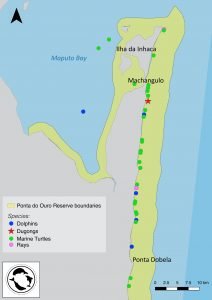
Seafari: Mobile App
Remember that with the application “Seafari”, you can also support the monitoring of dugongs and other marine species on the Mozambican coast. With Seafari it is possible to report the sighting of any marine species and to inquire about sightings made by others. The application is free and is available for Apple and Android devices in Portuguese and English.
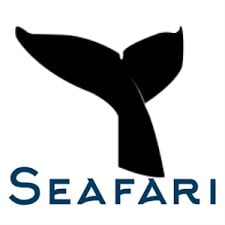
Education and awareness-raising of communities and fishers continue
During the month of April, the environmental education team held workshops on dugongs, other protected species and seagrass for teachers at six secondary schools in Inhambane province, in the communities of Nhamanhate, Mananisse, Mangarelane, Chibo, Petane and Mahoche. Lectures were also given to 135 students from five primary schools and 19 students from the Catholic Church Boarding School in Inhassoro.
In addition, education and awareness-raising activities were carried out with fishermen of the Community Fisheries Councils (CCP’s) in Nhamabue, Fequete, Petane and Vuca in order to identify the levels of knowledge of the fishermen and at the same time educate and sensitize them regarding the conservation of dugongs and seagrass.
It was found that the fishers are generally aware of the existence of protected species, and among them the dugongs, but few know the importance of these species.
During the training sessions, the fishers received new knowledge about the importance of dugongs as the protectors of the seagrass, which in turn harbor large numbers of fish.
They were also taught about the relationship between seagrass, dugongs and turtles, and the benefits of protected species and seagrass for the fishermen themselves.
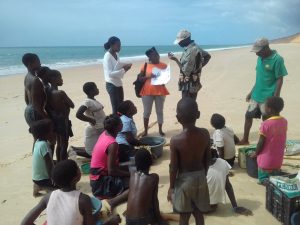
More information about the project
O projecto global: http://www.dugongconservation.org/
Os projectos em Moçambique: https://www.dugongs.org/research-in-east-africa/mozambique/
Facebook: https://www.facebook.com/mozdugong/